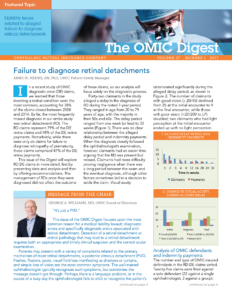
Policyholder Services
| << Back |
Liability coverage of eye banks that process ocular tissue
KIMBERLY K WYNKOOP, ESQ, OMIC General Counsel
OMIC has provided medical professional liability (MPL) insurance coverage to eye banks since 1999. Traditionally, eye banks procured, evaluated, and tested ocular tissue and then distributed the whole cornea or sclera to a surgeon. It was the responsibility of the surgeon to prepare the tissue as needed for the designated procedure. More recently, however, many eye banks provide an expanded scope of services. Surgeons may request tissue from an eye bank for a specific procedure, and the eye bank’s staff cuts, folds, shapes, or otherwise manipulates the tissue on the surgeon’s behalf. Some eye banks even load the prepared tissue into a sealed delivery system. In a 2016 survey of OMIC-insured eye banks, over 40% reported that they prepare tissue in one or more of these ways. While eye banks generally consider this tissue preparation a “service,” which OMIC’s policy covers, a plaintiff’s attorney might argue that it is “product” manufacturing, which OMIC’s policy excludes.
While the FDA Center for Biologics Evaluation and Research (CBER) regulates certain human tissue such as corneas intended for transplantation, it is likely that preparing ocular tissue would be only moderately subject to manufacturing oversight, and pre-market approval would not be required. Although tissue may be regulated somewhat like a product, this does not mean it is treated as such for liability purposes. Some state laws may specifically exclude human tissue as a “product.” In addition, nearly every state has a “blood shield statute” that prevents products liability claims based on tissue banking and transplantation. The rationale for these laws is the strong public policy interest in protecting persons and entities
that facilitate human blood, tissue, and organ donations for medical purposes.
However, some courts have had to determine whether certain types of human tissue fall under blood shield statutes when the tissue is not specifically listed. For example, while allografts (tissue from a donor of the same species but not genetically identical) have been determined not to be products, semen has.
 Blood shield statutes often preclude strict products liability claims based on statutory law (laws enacted by the state legislature), but may not prevent products liability claims based on common or case law (laws created through court decisions).
Blood shield statutes often preclude strict products liability claims based on statutory law (laws enacted by the state legislature), but may not prevent products liability claims based on common or case law (laws created through court decisions).
OMIC’s policy covers claims against eye banks that result from injury to a patient arising from eye bank services. Eye bank services are defined by the policy as “the provision of medical services at or on behalf of an eye bank, including the procurement, processing, testing, storing, and distribution of donor ocular tissue.” However, OMIC’s policy, like most professional liability policies, excludes “products” claims. The exclusion states, in part, that OMIC will not defend or pay damages for a claim that arises out of the producing, manufacturing, assembling, distributing, or selling of any medical device or other product, including the making of warranties or representations with respect to the use of the product.
If a lawsuit alleging malpractice were filed against an OMIC-insured eye bank by a patient alleging injury because of donor tissue processed or prepared by the eye bank, OMIC would cover that claim. However, due to the policy’s products exclusion, OMIC would be under no obligation to provide a defense or pay any damages if the suit were filed
exclusively as a products liability claim. If both professional and products liability allegations were made, OMIC would defend the lawsuit under a “reservation of rights.” This means that OMIC would hire an attorney to represent the insured in the lawsuit, but if there were damages awarded due to products liability, OMIC would not be obligated to pay them. The good news is that, in our experience with the few lawsuits that have been made against OMIC-insured eye banks, those pled as products liability claims are likely to be dismissed or amended to allege medical negligence, which is covered under OMIC’s policy.
Few, if any, malpractice insurers cover products liability because it poses a much greater risk than MPL. While a finding of negligence is always required in a malpractice action, a defendant in a products liability claim can often be found liable without any finding of negligence, instead based on “strict liability” or “breach of warranty.” The statute of limitations is also often longer for products liability cases, meaning the plaintiff can wait longer to sue the defendant. While malpractice litigation is often controlled by tort reform measures that limit damages, impose pre-trial requirements like certificates of merit and mediation, and otherwise control costs, these same protections don’t apply to product liability claims. Product liability claims can also give rise to punitive damages, while malpractice claims don’t unless there is a finding of gross misconduct. Class action lawsuits are also more common in product liability claims. For these reasons, MPL insurers exclude products liability coverage.
Where can products liability coverage be obtained?
General liability policies may include it under products liability or completed operations coverage. There are also a few stand-alone policies that provide this protection. For more information and reference materials for this article, please see omic.com.
Please refer to OMIC's Copyright and Disclaimer regarding the contents on this website





